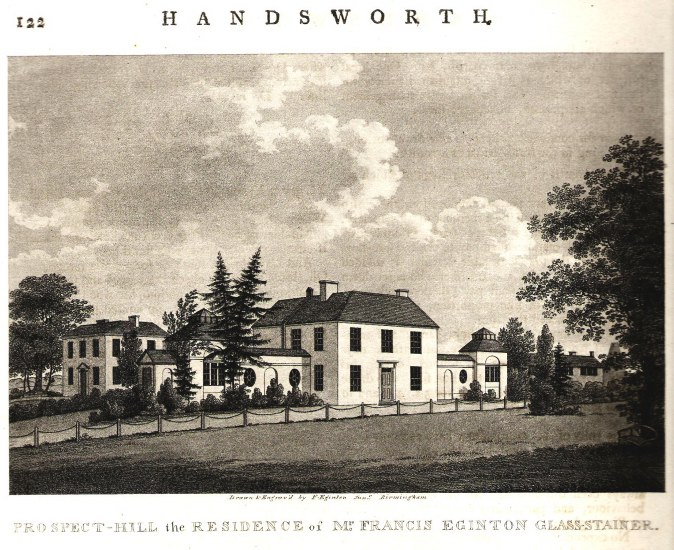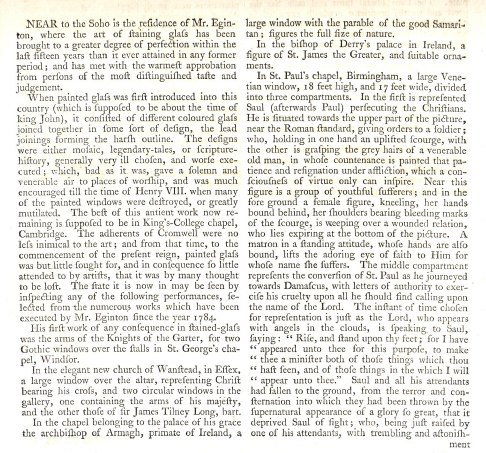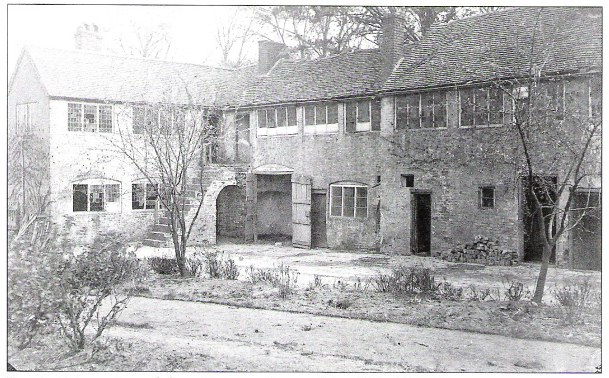

Near to the Soho is the residence of Mr Eginton, where the art of staining glass has been brought to a greater degree of perfection within the last fifteen years than it ever attained in any former period; and as met with the warmest approbation from persons of the most distinguished taste and judgement.
When painted glass was first introduced into this country (which is supposed to be about the time of King John), it consisted of different coloured glass joined together in some sort of design, the lead joining the harsh outline. The designs were either mosaic, legendary-tales or scripture-history, generally very ill chosen, and worse executed; which, bad as it was, gave a solemn and venerable air to places of worship, and was much encouraged till the time of Henry viii. When many of the painted windows were destroyed, or greatly mutilated. The best of this antient work now remaining is supposed to be in King's College chapel, Cambridge. The adherents of Cromwell were no less inimical to the art; and from that time, to the commencement of the present reign, painted glass was but little sought for, and in consequence so little attended to by artists, that it was thought by many to be lost. The state it is now in may be seen by inspecting any of the following performances, selected from the numerous works which have been executed by Mr Eginton since the year 1784.
His first work of any consequence in stained glass was the arms of the Knights of the Garter, for two gothic windows over the stalls in St George's chapel Windsor.
In the elegant new church of Wanstead, in Essex a large window over the altar, representing Christ bearing His cross, and two circular windows in the gallery, one containing the arms of hi majesty and the other those of Sir James Tilney Long, bart.
In the chapel belonging to the palace of His grace the archbishop of Armargh, primate of Ireland, and a large window with the parable of the Good Samaritan; figures the full size of nature. In the bishop of Derry's palace in Ireland, a figure of St James the Greater, and suitable ornaments.
In St Paul's Chapel, Birmingham, and a large Venetian window 18 feet high, and 17 feet wide, pided into three compartments. In the first is represented Saul (afterwards Paul) persecuting the Christians. He is situated towards the upper part of the picture near the Roman standard, giving orders to a soldier; who holding in one hand an uplifted scourge, with the other grasping the grey hairs of a venerable old man, in whose countenance is painted that patience resignation under affliction, which a consciousness of virtue only can inspire. Near this figure is a group of youthful sufferers; and in the fore ground a female figure, kneeling, her hands bound behind, her shoulders bearing bleeding marks of the scourge, is weeping at the bottom of the picture. A matron in standing attitude, whose hands are also bound, lifts the adoring eye of the faith to Him for whose name, she suffers. The middle compartment represents the conversion of St Paul as he journeyed towards Damascus, with the letters of authority to excise his cruelty upon all he should find calling upon the name of the Lord. The instant of time chosen for the representation is just as the Lord, who appears with the angels in the clouds, is speaking to Saul, saying: "Rife, and stand upon thy feet; for I have appeared unto thee for this purpose, to make thee a minister both of these things which thee have seen, and of those things in which I will appear unto thee. " Saul and all is attendants had fallen to the ground, from the terror and consternation into which they had been thrown by the supernatural appearance of a glory so great, that it deprived Saul of fight; who, being just raised by on of the attendants, with trembling astonishment.

